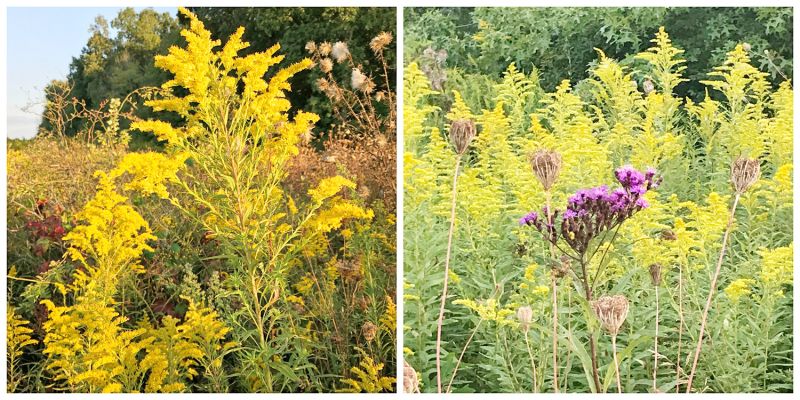Goldenrod is a dazzling introduction to the next season
- Michelle Wood: SWCD
- September 24, 2017
- 980
“Imagine a classroom with sky for a ceiling and earth for a floor. A room without walls or desks where young scientists explore the world of bugs, mathematicians measure rainfall, budding writers record their observations and actors rehearse on a natural stage.” — Boston Schoolyard Initiative.
Creating a classroom with a “sky for a ceiling and earth for a floor” is not as idealistic as it sounds. Outdoor learning can happen on any schoolyard that has even a tiny patch of green.
With a new school year, many teachers across the country — and locally — are including the schoolyard as a teaching tool. We often think of school as an indoor experience, but many teachers regularly use Mother Nature as a teaching assistant.
Nature makes abstract concepts more concrete. Take parallel lines for example. Traditionally we define the term and then show examples in a textbook or on a whiteboard. That’s a great beginning, but think how effective it is to then step outside and find examples of parallel lines on the school grounds. Immediately the concept is linked to real-world experience, and that leads to long-term learning.
Teachers also use the outdoors for a change of pace and place. Adding variety to teaching has long been associated with student motivation. Occasionally changing the location of instruction is an easy way to add the variety that energizes both students and teachers.
A change of pace and place may be something as simple as occasionally stepping outside to read a story or to have a class discussion. There is something about the fresh air, sky and sunlight that invigorates any activity.
Outdoor learning is not meant to replace indoor instruction. As L.B. Sharp, an early pioneer in experiential education, said decades ago, “That which can be best learned inside the classroom should be learned there. That which can be best learned in the out-of-doors through direct experience should there be learned.”
Outdoor learning is just one of many resources in a teacher’s instructional tool kit. It’s a powerful one though. Not only is it effective teaching, it has the added plus of getting kids outside and connected with the natural world, a good antidote for a world that is gorging on video vegetation.
Wildflower of the Month
Mention a new school year, and I immediately think of goldenrod. Years ago a brand of writing tablet called “Goldenrod” featured the plant on the cover. When stores displayed those tablets, summer was screeching to a halt, and school was straight ahead.
Goldenrod is beautiful, and it’s everywhere. Whether you are on an interstate highway or a county road, you can’t miss those tall plants with the bright yellow tops. Sometimes entire fields glow with thousands of plants. Tall purple ironweed plants frequently grow in the mix, creating a spectacular color palette. Goldenrod is a dazzling introduction to the next season.
Goldenrod also is an important late-summer food source. One publication mentions at least eight butterfly and moth species (Lepidoptera) feed exclusively on the flowers, and another 15 species feed on goldenrod in addition to other plants.
Then there are innumerable beetles, wasps, flies, bees and bumblebees that also make regular stops at the yellow flowers. Many insect predators also hang around goldenrod and turn some of the visitors into lunch.
Even after the plant dies back and frost coats the landscape, the seeds are a significant food source for several species of birds and small mammals. Goldenrod galls serve as both a food source and shelter for many types of birds, insects and other tiny organisms.
Just a few months ago the Cleveland Museum of Natural History published "Goldenrods of Northeast Ohio." This is a beautiful full-color guide that is devoted entirely to the 22 or so species found right around us. Check it out on the museum’s website at www.cmnh.org.
A new place to hike
The Friends of Wooster Memorial Park have announced construction is beginning on the Kenwood Acres ADA Nature Trail and entrance. Two handicapped-accessible trails will connect with Wooster Memorial Park.
The plan is for a 1-mile asphalt trail with boardwalks and overlooks as well as restrooms, a picnic area and a separate parking area. Tentative completion is the end of November. We live in a great area that is committed to providing resources for those who love nature but find it difficult to traverse a traditional hiking trail.
Contact Herb Broda at 4nature.notebook@gmail.com.




